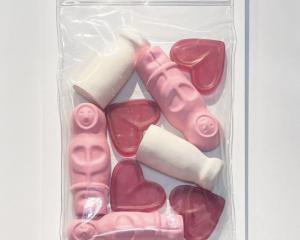When one thinks of traditional Japanese prints, the first image which comes to mind is that of Hokusai's most famous work, Under the wave off Kanagawa.
This piece is one of an extended series of woodblock prints which are connected by their subject, landscape views featuring that most sacred of Japanese landforms, Fujiyama.
Hokusai, whose life spanned the late 18th and early 19th centuries, was a master of ukiyo-e, a style of printed and painted art celebrating everyday life.
The term, meaning ''floating world'', originally encompassed images of social life but later included landscapes and images which captured features of both these subjects.
''36 Views of Mount Fuji'' was the first of several series of woodblock prints of the mountain by Hokusai. Created during the 1830s, it is widely regarded as a high point in Japanese landscape art.
Unlike many of his peers, Hokusai was influenced by both Japanese and Western art traditions. The combination of the two led to fine, appealing work .
The subtlety of the shading and the strength of line and composition are exceptional.
The current exhibition, featuring all the works from the series, is a wonderful opportunity to see this true Japanese master - if you'll pardon the pun - at his peak.
It is always enjoyable to see the stylised townscapes of Nic Dempster.
His painted structures, with their stained glass like blocks of bright colour separated by hard black lines, present the city as a kaleidoscope of wall, window, roof and sky.
The paintings are augmented by the wry wit of the titles, many of them here with tongue in cheek digs at real estate marketing.
Elsewhere, the titles hint at details in the paintings, drawing attention to what might otherwise have been overlooked.
In his latest exhibition, Dempster has experimentally tweaked his signature style.
This, for the artist, is partly an attempt to move away from the specifics of one particular city to a more generalised image of the urban world.
Ironically, several of the works displayed are more specific than normal, with the strongly Dunedin streetscapes of Chattels and Developers Dream.
In other works, however, Dempster has achieved his aim by reducing the town to a strong, almost Mondrian like grid.
This has produced an impressive abstract tinged image, and throws into sharp focus those works where more natural forms are present (such as the joyous parrot of Foreign Investor).
A further experiment, by leaving some parts of the surface board of the works unpainted, provides a bold edge to several of the pieces.
Zina Swanson's whimsical works frequently touch on human interaction with the environment.
In ''Concrete Dirt Parfait'', the artist bewilders and intrigues with a series of pictorial works accompanied by one small and two large installations.
Gone from Swanson's previous exhibitions is the study of plant life and the botanical environment, but both are to an extent implied in the two major installations.
Of these, Waterfall, with its patinated taps and hand blown glass in the shape of an industrial strength mountain stream, suggests an analogy between the uptake of water by plant roots and the human use of plumbing.
The pictorial Tropical Shower addresses this more directly, putting a bathroom cubicle in a rainforest scene.
The ''artificial rain'' device is placed ironically in a landscape where rain is the order of the day.
The environment, and our study of it, is also the subject of the graph like image Measuring air, measuring nothing, with its Magritte-like image of a cloud between two wooden ruler axes.
Other works in the exhibition, notably In Luck, show the artist's obsessiveness with detail.
This work, reminiscent of Australian Aboriginal dot art, builds up a ''handscape'' from the subtle, intricate shading of dot patterns to produce an effect which is simultaneously simplistic and impressive in its intensity.








![Untitled (c. mid 1990s, [pink 3]), by Martin Thompson, 415mm×590mm. Photo: courtesy of Brett...](https://www.odt.co.nz/sites/default/files/styles/odt_landscape_small_related_stories/public/story/2024/02/untitled_pink_3.jpg?itok=Q0aQrc9o)



